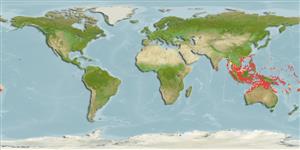Environment: milieu / climate zone / depth range / distribution range
Οικολογία
Θαλασσινό(ά); Υφάλμυρο Υφαλόφιλο(α); εύρος βάθους 5 - 80 m (Ref. 37816). Tropical; 25°N - 21°S
Indo-West Pacific: Thailand to Vanuatu, north to the Ryukyu Islands (Ref. 559) and southeast China, south to Australia.
Μέγεθος / Βάρος / Age
Maturity: Lm ? range ? - ? cm
Max length : 25.0 cm TL αρσενικό/απροσδιόριστο; (Ref. 48635)
Ραχιαίες άκανθες (συνολικά) : 15 - 17; Μαλακές ραχιαίες ακτίνες (συνολικά) : 7 - 9; Εδρικές άκανθες: 2; Μαλακές εδρικές ακτίνες: 10 - 12. Body colors highly variable and best identified by the patterns on the fins (Ref. 48635). Lower 2 pectoral rays are entirely free and used as "walking" legs and the inner face of the fin is brightly colored (Ref. 37816).
Found on open sandy or silty substrates of lagoon and seaward reefs. Often buries itself and easily overlooked. Uses pectoral fins to startle predators and shows color during courtship (Ref. 48635). Feeds on small fishes and crustaceans (Ref. 9710). The venom of this fish can be deadly to man. Its ability to camouflage itself by living half-buried presents a real danger. Solitary on sand and mud bottoms (Ref 90102).
Life cycle and mating behavior
Maturities | Αναπαραγωγή | Spawnings | Egg(s) | Fecundities | Προνύμφες
Myers, R.F., 1991. Micronesian reef fishes. Second Ed. Coral Graphics, Barrigada, Guam. 298 p. (Ref. 1602)
IUCN Red List Status (Ref. 130435)
Human uses
αλιεία: Εμπορικό(ά); Ενυδρείο: Εμπορικό(ά)
Εργαλεία
Special reports
Download XML
Διαδικτυακές πηγές
Estimates based on models
Preferred temperature (Ref.
123201): 26.3 - 29, mean 28.2 °C (based on 1088 cells).
Phylogenetic diversity index (Ref.
82804): PD
50 = 0.5010 [Uniqueness, from 0.5 = low to 2.0 = high].
Bayesian length-weight: a=0.01862 (0.01022 - 0.03394), b=2.89 (2.73 - 3.05), in cm total length, based on LWR estimates for this species & (Sub)family-body (Ref.
93245).
Τροφικό Επίπεδο (Ref.
69278): 4.0 ±0.66 se; based on food items.
Ελαστικότητα (Ref.
120179): Μεσαίο(α), ελάχιστος χρόνος για διπλασιασμό πληθυσμού 1,4 - 4,4 έτη (Preliminary K or Fecundity.).
Fishing Vulnerability (Ref.
59153): Low vulnerability (15 of 100).
Nutrients (Ref.
124155): Calcium = 55.4 [23.3, 140.2] mg/100g; Iron = 0.564 [0.265, 1.169] mg/100g; Protein = 18 [16, 20] %; Omega3 = 0.197 [0.081, 0.589] g/100g; Selenium = 31.7 [15.2, 76.9] μg/100g; VitaminA = 81.8 [20.5, 340.5] μg/100g; Zinc = 1.22 [0.79, 1.85] mg/100g (wet weight);
